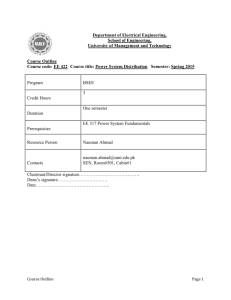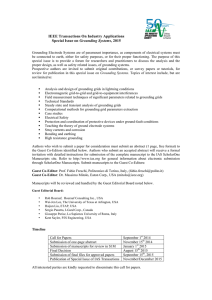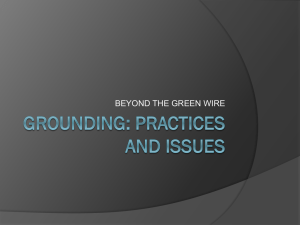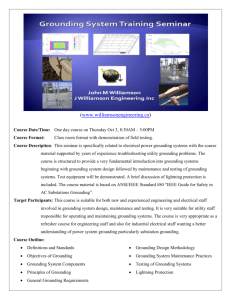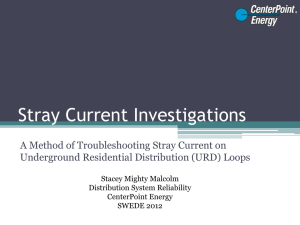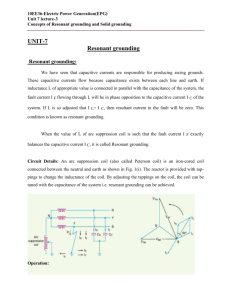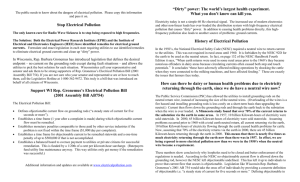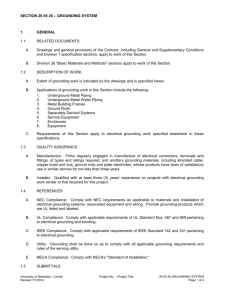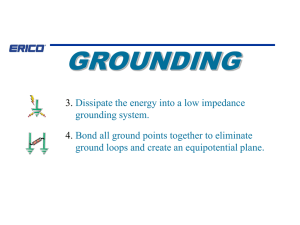Ignition or Shock - Theway Corp Home
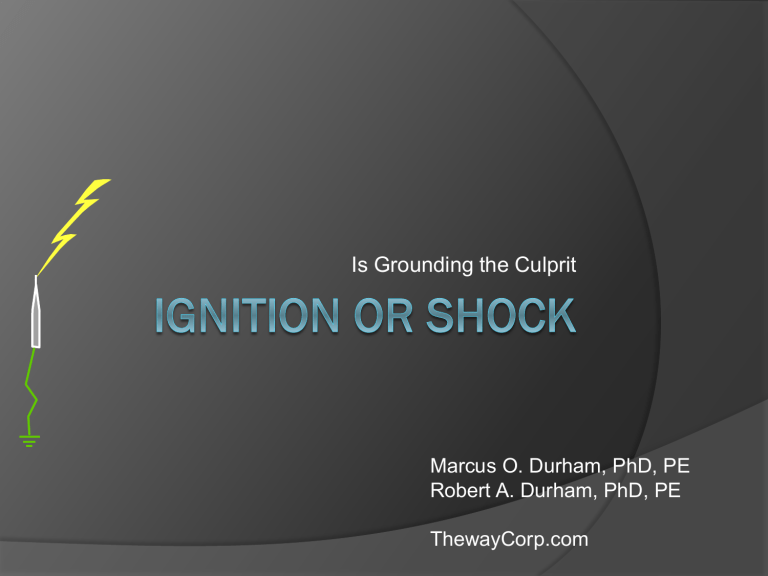
Is Grounding the Culprit
Marcus O. Durham, PhD, PE
Robert A. Durham, PhD, PE
ThewayCorp.com
What is the purpose of grounding?
Can grounding issues cause ignition or shock?
Where is a ground or return path used?
What is the difference between ground, bond, & neutral?
1
2
4
3
8
9
10
12
11
Why Ground ?
M.O. Durham
Theway Corp.
5
6
7
Grounding
Complex Topic
Critical for electrical safety
Biologic
Property
NEC - > 28 pages
NESC – Specific Requirements
IEEE – Multiple Standards
NFPA – Myriad Publications
Significance
Grounding is major element of every electrical system, but rarely understood
“Hot” cause shock or ignition only with return path – complete circuit
Either neutral (controlled) or ground
(uncontrolled) provides return
Electrical activity on neutral or ground – fault involving ground system
Ground is code and legal issue
Grounding System
Three components
Grounding Electrode
Contact point with earth
○
○
○
NEC <25 Ω or additional electrode required
NESC - < 25 Ω.
IEEE 142 - 25 Ω not satisfactory – 1-5Ω
Grounding Electrode Conductor
Connects grounding electrode to system
Must handle fault currents – NEC size
Z
V
I
120 V
20 A
Grounding system
Bonding
Connects metal surfaces to grounding system
Required between grounding electrodes
NEC FPN –bond all metal even if not specified
Vd
I
Without bond –
Potential difference exists between metals
Potential difference causes current flow
Neutral
Current carrying conductor
Controlled return path for 1 Φ & DC
Single point connection to ground
If multiple points –
current flows through grounding system
If poor connection –
Transformer circuit current can flow Entrance
Power H through ground
Neutral
Power H
Ground
Utility
Ground
Service
Ground
Load
Power H
Neutral
Ground
Water &
Other
Metal
Stray Current
Unintentional current flow through earth
Three causes
Neutral grounded at multiple points
Fault of “hot” wire to ground
Difference in potential of ground connections
Multi grounded neutral allows ~60% return current in earth
Allows V between metals and between metal and earth
Multi Point Neutral
Portion of I n flows through earth
Disturbances cause I flow in alternate routes
Risk of shock or equipment damage
I n
Transients
Short duration disturbances
Should be shunted to ground
Causes
Lightning
Utility Operations
Every On/Off of electrical circuit
Transients - Lightning
Lightning is natural phenomena
Uncontrolled – damage
Can be controlled
Industry standards and practices
Controlled – no or limited damage
Energization Issues
Three issues
Energized Ground
Floating Neutral
Energized Neutral
Energized Ground
I from another circuit
Caused by poor cnxns and poor ground Z
Melted insulation on ground wire or jacket
Energization Issues
Floating Neutral
Poor N connection
Allows return current on alternate path
Uncontrolled V levels
Energized Neutral
I returns on gnd (water pipe, etc.)
Melted neutral or ground insulation
Uncontrolled I flow
Faults
Three forms
Loss of Insulation
High Impedance Connection
Breaking faults
Loss of Insulation
V breakdown of dielectric
Heat, ejecta, loss of material
Easily recognized
Faults
High Z connection
Most common fault
Misaligned contacts
Poor connections
Partially damaged insulation
Not recognized by standard breakers
Heat exceeds ignition
Faults
Breaking Faults
Switching
Pulling apart cable
High frequency component
Sudden increase in voltage
Causes damage to insulation particularly at high inductance points (bends)
Why Fail Now?
A failure may not result in immediate catastrophe
Catastrophic failures are the result of multiple improper conditions.
Seldom do systems have serious consequences when only one component is improper.
Grounding Purpose
To ensure that all systems
(facility and service) are operating at the same POTENTIAL reference
To prevent circulating CURRENTS from developing in ground system
To allow building and service protection systems to operate effectively and as designed in TIME
Recap
Improper grounding and bonding is frequent problem
Electrical ignition and shock that is
“undetermined” is often grounding
Codes and standards are minimum requirements. Not following creates hazards
Grounding issues are code, then legal issues.
